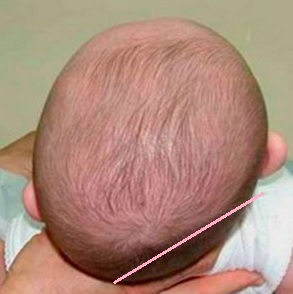As a chiropractor for babies something I have been seeing a lot of is babies with a flat spot on their head. Their mums or dads will bring them to me and say things like “I feel like it is getting worse” or “It hasn’t changed much since birth” or “He/She struggles to hold their head up straight”.
Flat head syndrome or as it is properly named plagiocephaly has been called the “most common craniofacial problem today” by the Royal children hospital and what we know from the research is that it is not just an aesthetic problem. Instead research is showing it being increasingly linked to developmental delays in later infancy and also into childhood.
That is why as a chiropractor for babies I work a lot with these babies to help balance out their cranium to try and restore proper movement to prevent the associated delays and prevent it from becoming an issue later on.
What Exactly is Plagiocephaly?
Plagiocephaly is characterised as a flattening of the skull on one side which gives the skull an asymmetric appearance. It also causes the ear on that side to stick out and forward more than the other and the front of the skull can slightly protrude as a compensation. A lot of the time this flat spot causes hair loss over the area.
The prevalence of plagiocephaly has increased over the last 20 years due to the recommendations for babies to sleep on their backs to prevent SIDS. By sleeping on their back they have prolonged pressure on one area of their soft skull which can cause it to become flat. This has led to a reduction in SIDS but as a consequence has increased the amount of cases of plagiocephaly.

That doesn’t answer the question as to why some babies who sleep on their back get plagiocephaly and others don’t. One factor is that whilst babies sleep/lay on their back they should be able to turn their head both ways. If a baby prefers to hold or turn their head one way or has an inability to turn one way that means they are putting more pressure through one side of their head.
The main thing I find that impacts a baby’s ability to turn their head is some form of neck restriction.
Neck restrictions in babies is pretty common due to the pressure placed through their neck both whilst in the womb and during birth.

In utero constraint can be a large factor leading to neck and cranium restrictions in babies. If the baby is breech or if they are twins/triplets as well as if the mother has a restricted or subluxated pelvis then the uterus will be limited in space causing pressure to the baby.
Birth is by far the most common cause of neck and skull restriction. Pressure to the head as it comes out of the birth canal can cause strain to the skull and the dural system (the protective layer of the spine). Whilst the distortion may not be evident straight after birth it tends to become more evident in the weeks following birth.
These restrictions can be very uncomfortable for a baby and can cause them from turning their head one way.
A lack of tummy time can also be associated with plagiocephaly. Babies need tummy time to help develop their neck strength as well as to help with development. Without a lot of tummy time they aren’t able to build their neck strength up and therefore control their head movements.
How Does Flat Head Sydnrome Impact My Child?
Unfortunately, there are still a lot of medical and health professionals out there who still see plagiocephaly as just a cosmetic problem and believe a child will just grow out of it.
However, what we know from the research is that we need to be taking this seriously and acting on it early as it may cause problems with a baby’s health and development in the long term.
The research very strongly supports that developmental delays are associated with plagiocephaly.
When it comes to developmental delays, I want to be clear in saying that just because your baby has a flat spot on their head does not mean that they will be delayed. It is not a causative factor but it is a correlation (two very different things!).
When it comes to developmental delays in infants it has been show that there is an association between deformational plagiocephaly and mental delay as well as with psychomotor skills (crawling, walking, other movements etc). In this study they showed that babies with plagiocephaly were more likely to exhibit mild-severe delays, but they also showed that none of these babies scored ‘accelerated” performance with developmental milestones.
“Research has suggested when the infant’s neck has limited movement, the infant will have a preference for a particular side to turn as they are unable to turn equally to both right and left. These findings also support research that cervical restriction and Plagiocephaly are linked with neurological disruption and developmental delay due to factors associated with inactivity and variable tone. It is unlikely that the association with developmental delay is due to the head deformation, but more likely to be related to the poor movement patterns associated with it. This highlights the need for manual therapy to restore normal range of motion and beneficial movement.”

In toddlers one study has shown that across three domains (cognitive, language and motor), children with plagiocephaly scored slightly lower than their non-affected peers.
Another problem that may be exacerbated by plagiocephaly is ear problems such as otitis media. This is speculated to be due to the change in shape of the cranium and how this effect the changing angle of the eustachian tube. One study showed that parental reports of ear infections were more common among those whose babies had plagiocephaly.
How Can Chiropractic Help Plagiocephaly?
It is important to note that children do not just ‘outgrow’ developmental delays without some form of help. Therefore, the easiest way to help them initially is to get their flat head looked at by a professional. In my opinion seeing a paediatric chiropractor is a great place to start!
When it comes to chiropractic and plagiocephaly the primary goal is not to change the shape of the infants head as this does not fix the underlying causative factor and by itself does not have a great effect on their development. In fact, the rounding of the head is the least important treatment outcome. Instead it is the development side of things we are more concerned with. However, as part of the treatment we see the head restore a more round shape due to the work we are doing to balance the cranium and nervous system.
Our goal when treating babies with a flat spot on their head is to restore proper motion within the spinal and cranial structures to allow for proper motor coordination. Movement is how babies develop and it is through movement that we develop strong nerve pathways that help us move better, organise our thoughts and actions and enable us to learn.
Chiropractic treatments for babies are very gentle and very specific and I find most babies tend to really enjoy their adjustments. Treatment includes very gentle neck movements to help restore motion, cranial work which is like a head massage and gentle stretching of their spine and dural system.
Along with the adjustments there are some specific at home exercises I get Mums and Dads to do with their babies that really help accelerate the improvement.
The good news is that in my clinical experience I find that babies respond really well to this style of treatment!


Recent Comments